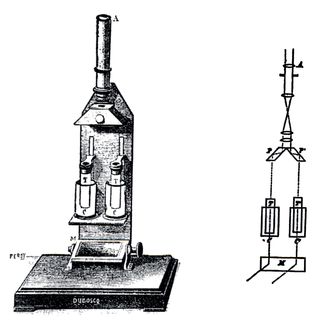| Look up concentration in Wiktionary, the free dictionary. |
Concentration can refer to:
| Look up concentration in Wiktionary, the free dictionary. |
Concentration can refer to:
In chemistry, concentration is the abundance of a constituent divided by the total volume of a mixture. Several types of mathematical description can be distinguished: mass concentration, molar concentration, number concentration, and volume concentration. A concentration can be any kind of chemical mixture, but most frequently solutes and solvents in solutions. The molar (amount) concentration has variants such as normal concentration and osmotic concentration.

In astronomy and astrophysics, a mass concentration is a region of a planet or moon's crust that contains a large positive gravitational anomaly. In general, the word "mascon" can be used as a noun to refer to an excess distribution of mass on or beneath the surface of an astronomical body, such as is found around Hawaii on Earth. However, this term is most often used to describe a geologic structure that has a positive gravitational anomaly associated with a feature that might otherwise have been expected to have a negative anomaly, such as the "mascon basins" on the Moon.
In physics, astronomy, chemistry, biology and geography, number density is an intensive quantity used to describe the degree of concentration of countable objects in physical space: three-dimensional volumetric number density, two-dimensional areal number density, or one-dimensional linear number density. Population density is an example of areal number density. The term number concentration is sometimes used in chemistry for the same quantity, particularly when comparing with other concentrations.

Concentration, also known as Match Match, Match Up, Memory, Pelmanism, Shinkei-suijaku, Pexeso or simply Pairs, is a card game in which all of the cards are laid face down on a surface and two cards are flipped face up over each turn. The object of the game is to turn over pairs of matching cards. Concentration can be played with any number of players or as solitaire. It is a particularly good game for young children, though adults may find it challenging and stimulating as well. The scheme is often used in quiz shows and can be employed as an educational game.
Concentration is an American television game show based on the children's memory game of the same name. Matching cards represented prizes that contestants could win. As matching pairs of cards were gradually removed from the board, it would slowly reveal elements of a rebus puzzle that contestants had to solve to win a match.

Concentration is a music album by artists Machines of Loving Grace which was released in 1993. The song "Butterfly Wings" achieved moderate success and appeared on the soundtrack to the film Punisher: War Zone, as well as the TV Series Due South.

Attentional control refers to an individual's capacity to choose what they pay attention to and what they ignore. It is also known as endogenous attention or executive attention. In lay terms, attentional control can be described as an individual's ability to concentrate. Primarily mediated by the frontal areas of the brain including the anterior cingulate cortex, attentional control is thought to be closely related to other executive functions such as working memory.
In economics, market concentration is a function of the number of firms and their respective shares of the total production in a market. Alternative terms are Industry concentration and Seller concentration.
The most common concentration ratios are the CR4 and the CR8, which means the market share of the four and the eight largest firms. Concentration ratios are usually used to show the extent of market control of the largest firms in the industry and to illustrate the degree to which an industry is oligopolistic.
Force concentration is the practice of concentrating a military force so as to bring to bear such overwhelming force against a portion of an enemy force that the disparity between the two forces alone acts as a force multiplier in favour of the concentrated forces.
| This disambiguation page lists articles associated with the title Concentration. If an internal link led you here, you may wish to change the link to point directly to the intended article. |
Physical science is a branch of natural science that studies non-living systems, in contrast to life science. It in turn has many branches, each referred to as a "physical science", together called the "physical sciences".
The mole is the base unit of amount of substance in the International System of Units (SI). Effective 20 May 2019, the mole is defined as the amount of a chemical substance that contains exactly 6.02214076×1023 (Avogadro constant) constitutive particles, e.g., atoms, molecules, ions or electrons.
A phase diagram in physical chemistry, engineering, mineralogy, and materials science is a type of chart used to show conditions at which thermodynamically distinct phases occur and coexist at equilibrium.
MPC, Mpc or mpc may refer to:

An academic discipline or field of study is a branch of knowledge, taught and researched as part of higher education. A scholar's discipline is commonly defined by the university faculties and learned societies to which he or she belongs and the academic journals in which he or she publishes research.
Mixtures In chemistry, a mixture is a material made up of two or more different substances which are mixed. A mixture refers to the physical combination of two or more substances in which the identities are retained and are mixed in the form of solutions, suspensions and colloids.

In chemistry, spectrophotometry is the quantitative measurement of the reflection or transmission properties of a material as a function of wavelength. It is more specific than the general term electromagnetic spectroscopy in that spectrophotometry deals with visible light, near-ultraviolet, and near-infrared, but does not cover time-resolved spectroscopic techniques.

Gas chromatography (GC) is a common type of chromatography used in analytical chemistry for separating and analyzing compounds that can be vaporized without decomposition. Typical uses of GC include testing the purity of a particular substance, or separating the different components of a mixture. In some situations, GC may help in identifying a compound. In preparative chromatography, GC can be used to prepare pure compounds from a mixture.
Amount of substance is a standard-defined quantity that measures the size of an ensemble of particles, such as atoms, molecules, electrons, and other particles. It is sometimes referred to as chemical amount. The International System of Units (SI) defines the amount of substance to be proportional to the number of entities present. The SI unit for amount of substance is the mole. It has the unit symbol mol. The proportionality constant is the inverse of the Avogadro constant.
An analyte, component, or chemical species is a substance or chemical constituent that is of interest in an analytical procedure.
Greek letters are used in mathematics, science, engineering, and other areas where mathematical notation is used as symbols for constants, special functions, and also conventionally for variables representing certain quantities. In these contexts, the capital letters and the small letters represent distinct and unrelated entities. Those Greek letters which have the same form as Latin letters are rarely used: capital A, B, E, Z, H, I, K, M, N, O, P, T, Y, X. Small ι, ο and υ are also rarely used, since they closely resemble the Latin letters i, o and u. Sometimes font variants of Greek letters are used as distinct symbols in mathematics, in particular for ε/ϵ and π/ϖ. The archaic letter digamma (Ϝ/ϝ/ϛ) is sometimes used.

The College of Arts, Sciences, and Engineering is one of the primary units of the University of Rochester, encompassing the majority of the undergraduate and graduate enrollment. The College is divided in the units of Arts and Sciences and the School of Engineering and Applied Sciences. The College is located on the River Campus of the University of Rochester, though some departments maintain facilities on other campuses. The College was established in 1955 upon the merger of the separate colleges for men and women at the university.
ISO 31-8 is the part of international standard ISO 31 that defines names and symbols for quantities and units related to physical chemistry and molecular physics.

Wet chemistry is a form of analytical chemistry that uses classical methods such as observation to analyze materials. It is called wet chemistry since most analyzing is done in the liquid phase. Wet chemistry is also called bench chemistry since many tests are performed at lab benches.
N is the fourteenth letter of the Latin alphabet.
An academic discipline or academic field, also known as a field of study, field of inquiry, research field and branch of knowledge, is a subdivision of knowledge that is taught and researched at the college or university level. Disciplines are defined, and recognized by the academic journals in which research is published, and the learned societies and academic departments or faculties to which their practitioners belong. It includes scientific disciplines.

In physical and analytical chemistry, colorimetry or colourimetry is a technique "used to determine the concentration of colored compounds in solution." A colorimeter is a device used to test the concentration of a solution by measuring its absorbance of a specific wavelength of light.
In analytical chemistry, biomonitoring is the measurement of the body burden of toxic chemical compounds, elements, or their metabolites, in biological substances. Often, these measurements are done in blood and urine.

A measuring instrument is a device for measuring a physical quantity. In the physical sciences, quality assurance, and engineering, measurement is the activity of obtaining and comparing physical quantities of real-world objects and events. Established standard objects and events are used as units, and the process of measurement gives a number relating the item under study and the referenced unit of measurement. Measuring instruments, and formal test methods which define the instrument's use, are the means by which these relations of numbers are obtained. All measuring instruments are subject to varying degrees of instrument error and measurement uncertainty.